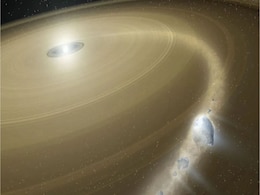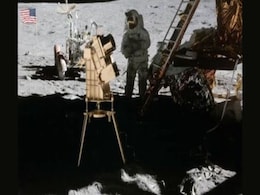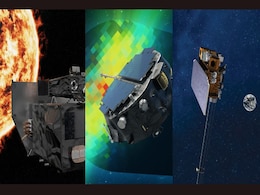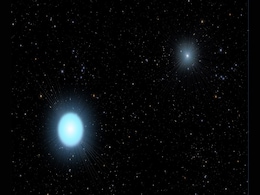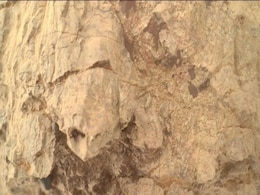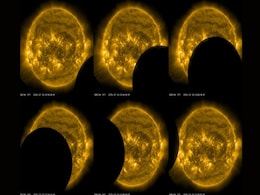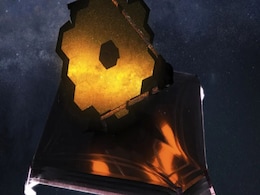Ultraviolet
- All
- News
- Videos
- Web Stories
-

James Webb Space Telescope Finds Unexpected Ultraviolet Radiation Around Young Protostars
- Monday December 1, 2025
Astronomers using the James Webb Space Telescope have detected unexpected ultraviolet radiation around five young protostars in the Ophiuchus molecular cloud. Since infant stars are not expected to emit UV light, the finding challenges long-standing star-formation models. Researchers ruled out external illumination from nearby stars, concluding the...
-
 www.gadgets360.com
www.gadgets360.com
-

NASA May Have Detected Oldest Stars In Universe Formed After Big Bang
- Friday November 21, 2025
- Feature |
NASA's James Webb Space Telescope may have detected the universe's oldest Population III stars in galaxy LAP1-B, 13 billion light-years away.
-
 www.ndtv.com
www.ndtv.com
-

After 4 Rain Delays In Perth, UV Lights Used On Adelaide Oval Pitch Amid Heavy Rain Ahead Of 2nd ODI
- Tuesday October 21, 2025
Stadium officials used ultraviolet (UV) lights to apply external heat to the pitch at the Adelaide Oval ahead of Thursday's encounter.
-
 sports.ndtv.com
sports.ndtv.com
-

SpaceX Launches IMAP, CGO, SWFO-L1 to Probe Solar Frontier and Space Weather
- Sunday September 28, 2025
A Falcon 9 lifted off from Kennedy Space Center on Sept. 24, 2025, carrying NASA’s IMAP, CGO, and SWFO-L1 spacecraft. The mission aims to chart the heliosphere’s boundary, monitor Earth’s geocorona, and deliver constant space-weather alerts, protecting satellites and astronauts while expanding knowledge of the solar system’s outer edge.
-
 www.gadgets360.com
www.gadgets360.com
-

Hubble Spots White Dwarf Devouring Icy Pluto-Like Planet 260 Light-Years Away
- Wednesday September 24, 2025
Using Hubble’s ultraviolet spectrograph, scientists detected carbon, nitrogen, sulphur, and abundant oxygen falling onto a white dwarf 260 light-years away, evidence of an icy planetesimal being torn apart. The find shows volatile worlds can persist into a star’s final stages, offering a preview of the Sun’s distant fate.
-
 www.gadgets360.com
www.gadgets360.com
-

NASA Prepares 2025 Carruthers Mission to Explore Earth’s Hidden Hydrogen Halo
- Friday September 26, 2025
NASA’s Carruthers Geocorona Observatory, launching in 2025, will capture ultraviolet light from hydrogen atoms to map Earth’s faint geocorona. Operating a million miles sunward, it will study how solar activity drives atmospheric loss, improves satellite protection, and reveals clues to planetary habitability, providing critical insight for fut...
-
 www.gadgets360.com
www.gadgets360.com
-

IMAP Space Weather Mission to Lift Off Soon, NASA Confirms Broadcast Plans
- Thursday September 18, 2025
NASA will stream the Sept. 23 launch of IMAP with two rideshare satellites from Kennedy Space Centre. IMAP will study the heliosphere, Carruthers will image Earth’s exosphere, and NOAA’s SWFO-L1 will provide early solar storm warnings. Together, the missions advance space weather science while protecting satellites, communications, and power sy...
-
 www.gadgets360.com
www.gadgets360.com
-

NASA Hubble Space Telescope Uncovers One of the Youngest Known Blue Straggler–White Dwarf Systems
- Thursday September 11, 2025
Italian astronomers using the Hubble Space Telescope have discovered a white dwarf orbiting a blue straggler star in the globular cluster 47 Tucanae, located 15,300 light-years away. The rare system, among the youngest detected, sheds light on stellar mass transfer and offers vital clues to the evolution of binary stars in dense clusters.
-
 www.gadgets360.com
www.gadgets360.com
-

NASA’s Perseverance Rover Spots Turtle-Shaped Rock in Mars’ Jezero Crater
- Thursday September 11, 2025
Perseverance rover snaps turtle-shaped rock in Jezero Crater, a geologic oddity shaped by erosion and human pareidolia. The picture was snapped on Sol 1,610, August 31, 2025, at Jezero Crater, by the rover's Sherloc and Watson instruments, fitted to its robotic arm, which capture visible and ultraviolet images of rock surfaces.
-
 www.gadgets360.com
www.gadgets360.com
-

NASA’s Solar Observatory Sees Two Eclipses in One Day
- Tuesday July 29, 2025
In a rare celestial event, NASA’s Solar Dynamics Observatory (SDO) captured two eclipses on July 25, 2025. First, at 2:45 UTC, the Moon passed between SDO and the Sun, covering about 62% of the solar disk. Just hours later, around 6:30 UTC, Earth itself blocked the Sun entirely from SDO’s perspective. These dual eclipses occurred during SDO’s...
-
 www.gadgets360.com
www.gadgets360.com
-

James Webb Telescope Spots Planet Formation in Harshest Known Galactic Environments
- Sunday June 22, 2025
The James Webb Space Telescope has revealed that planets can form in extreme radiation zones. A protoplanetary disk called XUE 1, exposed to intense ultraviolet light, still shows signs of water and potential for rocky planet formation. The findings challenge old assumptions and broaden the possible regions where Earth-like planets may emerge.
-
 www.gadgets360.com
www.gadgets360.com
-

Is Mars Really Red? A Physicist Explains the Science Behind Its Colour and More
- Saturday June 21, 2025
A physicist explains the science behind Mars’s red appearance, linking its hue to iron oxide or rust. While known as the Red Planet, rover images and telescope data show varied colors, from tan to white ice caps. Observations in ultraviolet and infrared light reveal deeper insights into Mars’s atmosphere, surface, and seasonal changes, enrichin...
-
 www.gadgets360.com
www.gadgets360.com
-

Netherland’s ASML Is the Most Important Company Behind the Global Rise of AI: 5 Things You Should Know
- Thursday June 19, 2025
Extreme ultraviolet (EUV) lithography machines are the only such systems that can inscribe transistors smaller than 7nm on a microchip. This means everything from a modern smartphones, powerful GPUs, and data servers powering the compute for advanced AI models are all developed using this technology. And, there is only company in the world that man...
-
 www.gadgets360.com
www.gadgets360.com
-

James Webb Space Telescope Finds Unexpected Ultraviolet Radiation Around Young Protostars
- Monday December 1, 2025
Astronomers using the James Webb Space Telescope have detected unexpected ultraviolet radiation around five young protostars in the Ophiuchus molecular cloud. Since infant stars are not expected to emit UV light, the finding challenges long-standing star-formation models. Researchers ruled out external illumination from nearby stars, concluding the...
-
 www.gadgets360.com
www.gadgets360.com
-

NASA May Have Detected Oldest Stars In Universe Formed After Big Bang
- Friday November 21, 2025
- Feature |
NASA's James Webb Space Telescope may have detected the universe's oldest Population III stars in galaxy LAP1-B, 13 billion light-years away.
-
 www.ndtv.com
www.ndtv.com
-

After 4 Rain Delays In Perth, UV Lights Used On Adelaide Oval Pitch Amid Heavy Rain Ahead Of 2nd ODI
- Tuesday October 21, 2025
Stadium officials used ultraviolet (UV) lights to apply external heat to the pitch at the Adelaide Oval ahead of Thursday's encounter.
-
 sports.ndtv.com
sports.ndtv.com
-

SpaceX Launches IMAP, CGO, SWFO-L1 to Probe Solar Frontier and Space Weather
- Sunday September 28, 2025
A Falcon 9 lifted off from Kennedy Space Center on Sept. 24, 2025, carrying NASA’s IMAP, CGO, and SWFO-L1 spacecraft. The mission aims to chart the heliosphere’s boundary, monitor Earth’s geocorona, and deliver constant space-weather alerts, protecting satellites and astronauts while expanding knowledge of the solar system’s outer edge.
-
 www.gadgets360.com
www.gadgets360.com
-

Hubble Spots White Dwarf Devouring Icy Pluto-Like Planet 260 Light-Years Away
- Wednesday September 24, 2025
Using Hubble’s ultraviolet spectrograph, scientists detected carbon, nitrogen, sulphur, and abundant oxygen falling onto a white dwarf 260 light-years away, evidence of an icy planetesimal being torn apart. The find shows volatile worlds can persist into a star’s final stages, offering a preview of the Sun’s distant fate.
-
 www.gadgets360.com
www.gadgets360.com
-

NASA Prepares 2025 Carruthers Mission to Explore Earth’s Hidden Hydrogen Halo
- Friday September 26, 2025
NASA’s Carruthers Geocorona Observatory, launching in 2025, will capture ultraviolet light from hydrogen atoms to map Earth’s faint geocorona. Operating a million miles sunward, it will study how solar activity drives atmospheric loss, improves satellite protection, and reveals clues to planetary habitability, providing critical insight for fut...
-
 www.gadgets360.com
www.gadgets360.com
-

IMAP Space Weather Mission to Lift Off Soon, NASA Confirms Broadcast Plans
- Thursday September 18, 2025
NASA will stream the Sept. 23 launch of IMAP with two rideshare satellites from Kennedy Space Centre. IMAP will study the heliosphere, Carruthers will image Earth’s exosphere, and NOAA’s SWFO-L1 will provide early solar storm warnings. Together, the missions advance space weather science while protecting satellites, communications, and power sy...
-
 www.gadgets360.com
www.gadgets360.com
-

NASA Hubble Space Telescope Uncovers One of the Youngest Known Blue Straggler–White Dwarf Systems
- Thursday September 11, 2025
Italian astronomers using the Hubble Space Telescope have discovered a white dwarf orbiting a blue straggler star in the globular cluster 47 Tucanae, located 15,300 light-years away. The rare system, among the youngest detected, sheds light on stellar mass transfer and offers vital clues to the evolution of binary stars in dense clusters.
-
 www.gadgets360.com
www.gadgets360.com
-

NASA’s Perseverance Rover Spots Turtle-Shaped Rock in Mars’ Jezero Crater
- Thursday September 11, 2025
Perseverance rover snaps turtle-shaped rock in Jezero Crater, a geologic oddity shaped by erosion and human pareidolia. The picture was snapped on Sol 1,610, August 31, 2025, at Jezero Crater, by the rover's Sherloc and Watson instruments, fitted to its robotic arm, which capture visible and ultraviolet images of rock surfaces.
-
 www.gadgets360.com
www.gadgets360.com
-

NASA’s Solar Observatory Sees Two Eclipses in One Day
- Tuesday July 29, 2025
In a rare celestial event, NASA’s Solar Dynamics Observatory (SDO) captured two eclipses on July 25, 2025. First, at 2:45 UTC, the Moon passed between SDO and the Sun, covering about 62% of the solar disk. Just hours later, around 6:30 UTC, Earth itself blocked the Sun entirely from SDO’s perspective. These dual eclipses occurred during SDO’s...
-
 www.gadgets360.com
www.gadgets360.com
-

James Webb Telescope Spots Planet Formation in Harshest Known Galactic Environments
- Sunday June 22, 2025
The James Webb Space Telescope has revealed that planets can form in extreme radiation zones. A protoplanetary disk called XUE 1, exposed to intense ultraviolet light, still shows signs of water and potential for rocky planet formation. The findings challenge old assumptions and broaden the possible regions where Earth-like planets may emerge.
-
 www.gadgets360.com
www.gadgets360.com
-

Is Mars Really Red? A Physicist Explains the Science Behind Its Colour and More
- Saturday June 21, 2025
A physicist explains the science behind Mars’s red appearance, linking its hue to iron oxide or rust. While known as the Red Planet, rover images and telescope data show varied colors, from tan to white ice caps. Observations in ultraviolet and infrared light reveal deeper insights into Mars’s atmosphere, surface, and seasonal changes, enrichin...
-
 www.gadgets360.com
www.gadgets360.com
-

Netherland’s ASML Is the Most Important Company Behind the Global Rise of AI: 5 Things You Should Know
- Thursday June 19, 2025
Extreme ultraviolet (EUV) lithography machines are the only such systems that can inscribe transistors smaller than 7nm on a microchip. This means everything from a modern smartphones, powerful GPUs, and data servers powering the compute for advanced AI models are all developed using this technology. And, there is only company in the world that man...
-
 www.gadgets360.com
www.gadgets360.com







